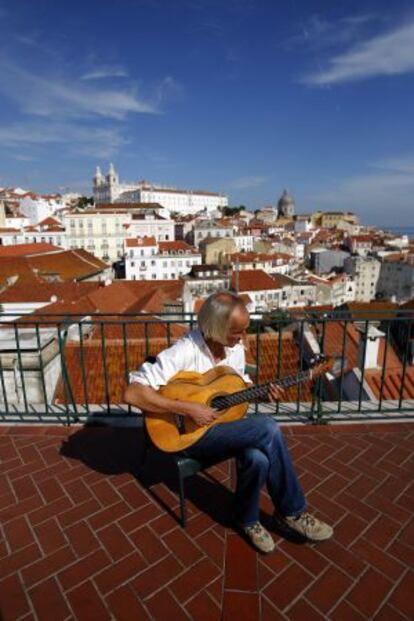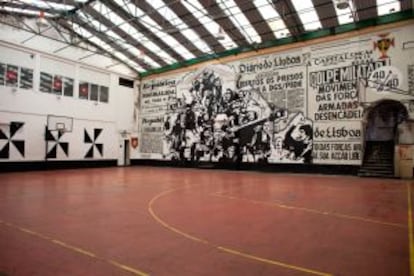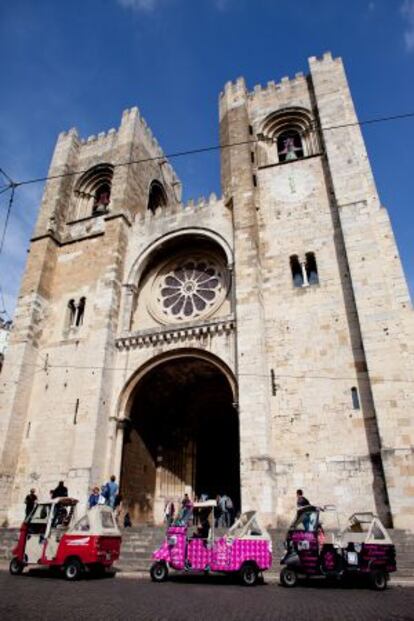The allure of Lisbon
Portugal’s capital is experiencing a tourism boom like no other major European city EL PAÍS singles out some of its lesser-known spots in search of the secrets of its success

Mamma Isabel has prepared a creamy cod and spinach soup for the 40 people staying at Home Lisbon. Of the 70,000 youth hostels listed around the world, this one in Lisbon’s historic city center is considered one of the best: it is a former winner of the HostelWorld award in the midsize establishment category.
“We don’t really know why,” explains Bárbara, Mamma Isabel’s sister-in-law and the hostel manager. “It’s the guests who vote on the website. We think the difference may lie in our atmosphere. You never feel at home in a hotel, but you do here.”
Lisbon was the European capital that experienced the greatest tourism growth in 2013, registering a 15.3-percent rise in visitor numbers from 2012. And the trend is not set to stop any time soon. Seventeen new hotels are expected to open in the Portuguese capital this year, and many of them are housed inside historic mansions that have been restored to their former splendor.
People come here with lower expectations, then when they see what the city has to offer, they go away with a really great impression”
Paula Oliveira, Lisbon tourism director
Out on the street, the rattling sound of the number 28 tram can be heard as the wooden vehicle from another era makes its nostalgic way down from the Cemetery of Prazeres, then climbs back up to Camões square, passes the famous A Brasileira café, and runs by old haberdasheries that still sell sewing thread, needles and embroidery.
Chain stores and franchises have not quite managed – not yet – to extinguish this neighborhood from a time gone by, where products are still sold by the meter and the gram, and owners personally run their own businesses. They are still standing behind their counters because, barring fires and earthquakes, Lisbon can withstand just about anything.

“People come here with lower expectations, then when they see what the city has to offer, they go away with a really great impression,” notes Paula Oliveira, the city’s tourism director. “There is not one single icon that represents the city: its charm lies in a combination of everything – culture, a friendly atmosphere, a good climate, gastronomy and options for relaxation. Everything can be accessed on foot and you don’t have the stress of necessarily having to visit this or that landmark.”
Surveys show Lisbon scoring 9.3 out of 10 for tourist satisfaction, with 62 percent of visitors saying they will return. The Portuguese capital is now receiving the same kind of passionate attention that Berlin enjoyed after the fall of the Wall, or Barcelona when it became an Olympic city.
Lisbon has miraculously resisted the kind of transformation that's turned so many other cities into tourist theme parks. Here there is still room for passion unrestricted by security guards or laws. At night, Bairro Alto and Cais de Sodre fill up with enthusiastic drinkers, and on rainy days partygoers skip and jump in the streets while trying to avoid the passing cars that resemble semi-submerged submarines.

This is the place that so fascinated British photographer Camilla Watson that she decided to stay. Her portraits of her neighbors adorn the walls of La Morería neighborhood, where people still say good morning, good afternoon and good evening to one another as they pass by among the washing hanging on the lines and the smell of curry wafting through the air.
It was in an unassuming alley under the São Jorge Castle that fado, the quintessential Portuguese musical genre, is said to have begun, as the lament of a prostitute singing to herself. Over in the next lane, visitors can still see the house that the Jesuit priests built before heading out to conquer faraway places such as Mozambique and Goa.
There is no other capital in the world whose downtown is populated with people from so many continents. Rich Angolans go shopping on Avenida da Liberdade. European artists have taken over São Paulo street. La Palma is the holdout of the Chinese from Macao, while Indians from Goa like to hang out in Benformoso.

Bureaucratic Lisbon owes this magical vitality to its former colonies, where people who were once subjects of Portugal have taken over the metropolis with their music, literature, food and even their television soaps.
Sitting among a group of young and not-so-young guests from a dozen countries, Mamma Isabel raises her glass and makes a toast along with a Canadian man who was supposed to have stayed two days but has already been here close to two months.
“To Mamma’s toast!” cries out a Norwegian man. Mamma Isabel swells with pride. “I adore this life,” she confesses.
Displaying the same kind of self-confidence, tourism director Oliveira confides the uninimitable secret of Lisbon’s success: “Lisbon is not about its monuments, it’s about its feelings.”
The city encourages travelers to discover their own favorite spots. If one is ready to walk around without a fixed goal and leave prejudice behind, surprises are guaranteed. The following are some marvelous yet lesser-known spots in Lisbon.
01 Ateneo Comercial

Walking into this palace is like traveling through a time tunnel. Head upstairs and push through the large wooden doors that open out into a maze of rooms featuring Rococo lamps, swimming pools and a derelict gym. At night, this setting right out of Blade Runner transforms into a pub for a unique crowd.
Rua das Portas de Santo Antão, 110.
02 Jardín Tropical
The hustle and bustle that surrounds the Jerónimos Monastery and the Pastéis de Belém bakery conceals this haven of peace. Created in 1906 as a colonial garden, it is no collection of pines, oaks and flowers, but a recreation of the jungle. The intimacy provided by the winding paths, brooks, lagoons and sculptures of indigenous peoples take visitors straight to exuberant Macao.
Largo dos Jerónimos.
03 Vila Berta

This industrial colony is concealed behind the final stop of the 28 tram line, at the top of the Graça neighborhood. The narrow alley with twin rows of houses fronted by wrought-iron balconies was created in the early 20th century for Lisbon’s blue-collar workers.
Rua Vila Berta.
04 Campo de Ourique
There is nothing spectacular about this neighborhood, yet there is something charming about its harmonious architecture, its four-story buildings and its 1960s rationalist style. Tourists will want to see the home of writer Fernando Pessoa and the former municipal market, which now serves gourmet food.
05 Santo Amaro Chapel
A group of Galician sailors built this chapel over the Tagus river in 1549, or so the story goes. Since the middle of the 20th century, it has been located under the 25 de Abril bridge. This semi-abandoned urban oasis is only open to the public on rare occasions, but visitors are always welcome to take a look at its semi-circular atrium covered with colorful tiles that remain almost intact.
Calçada de Santo Amaro.

06 Plaça das Amoreiras
This quiet, shady, hard-to-find square features a friendly kiosk serving emergency fare (coffee and soup). In a corner stands the Mãe d’Água, a subterranean cistern that back in the 19th century was used to collect water from an aqueduct.
07 Burnay Palace
This once housed the Spanish embassy, but owes its name to the banker who subsequently bought the building and adorned it with paintings and stucco work. These days, it is home to some official agency or other that is keeping it under wraps, except for the entrance hall, which is wonderful enough to be worth the visit.
Rua da Junqueira, 86.
08 Jardín Bordallo Pinheiro

If Barcelona has Gaudí, Lisbon has Rafael Bordallo Pinheiro (1846-1905), a draftsman and ceramics artist who, unlike the Catalan architect, did not suck up to the powerful but made fun of them instead. The City Museum has recreated his garden and included many of his nature sculptures: giant lizards climb the walls, little seahorses, crabs and mussels peek out of the fountains, macaws stare down from the trees, snails appear to make their slow way across the sand, and a black cat watches over the entire mad scenario.
Campo Grande, 245.
09 The English Cemetery
Opened in 1724 as a burial place for heathen Britons, this is the oldest graveyard in the city and a haven of peace with a long collection of curious stories. Right across the street is the romantic garden of Estrela, with its endearing bandstand and food stall.
10 Military Museum
The courtyard that holds the cannons is a unique sight. Its four walls feature tile mosaics depicting the most important battles in the history of Portugal, from the reconquest of Lisbon to World War I.
Largo Museu da Artilharia.
Tu suscripción se está usando en otro dispositivo
¿Quieres añadir otro usuario a tu suscripción?
Si continúas leyendo en este dispositivo, no se podrá leer en el otro.
FlechaTu suscripción se está usando en otro dispositivo y solo puedes acceder a EL PAÍS desde un dispositivo a la vez.
Si quieres compartir tu cuenta, cambia tu suscripción a la modalidad Premium, así podrás añadir otro usuario. Cada uno accederá con su propia cuenta de email, lo que os permitirá personalizar vuestra experiencia en EL PAÍS.
¿Tienes una suscripción de empresa? Accede aquí para contratar más cuentas.
En el caso de no saber quién está usando tu cuenta, te recomendamos cambiar tu contraseña aquí.
Si decides continuar compartiendo tu cuenta, este mensaje se mostrará en tu dispositivo y en el de la otra persona que está usando tu cuenta de forma indefinida, afectando a tu experiencia de lectura. Puedes consultar aquí los términos y condiciones de la suscripción digital.
Últimas noticias
The complicated life of Francesca Albanese: A rising figure in Italy but barred from every bank by Trump’s sanctions
How Japan is trying to avert ‘digital defeat’
Half of Scotland is in the hands of 420 property owners
Reinhard Genzel, Nobel laureate in physics: ‘One-minute videos will never give you the truth’
Most viewed
- Pablo Escobar’s hippos: A serious environmental problem, 40 years on
- Reinhard Genzel, Nobel laureate in physics: ‘One-minute videos will never give you the truth’
- Why we lost the habit of sleeping in two segments and how that changed our sense of time
- Charles Dubouloz, mountaineering star, retires at 36 with a farewell tour inspired by Walter Bonatti
- The Florida Keys tourist paradise is besieged by immigration agents: ‘We’ve never seen anything like this’








































